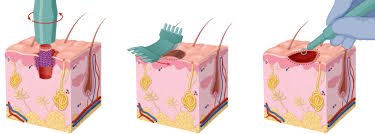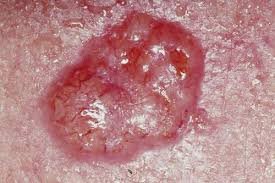

Aberrant Basal Cell Carcinoma (BCC) refers to a rare or unusual presentation of basal cell carcinoma, which is the most common type of skin cancer. While typical BCCs arise from the basal cells of the epidermis and have predictable clinical and histopathological features, aberrant BCCs deviate from the norm in location, appearance, behavior, or differentiation.
🔍 Key Features of Aberrant Basal Cell Carcinoma
1. Unusual Locations
Ectopic BCC: Occurs in areas typically not exposed to the sun or with minimal basal cells, like:
Perianal region
Scrotum
Nipple-areola complex
Mucosal sites (rare)
These areas are considered “aberrant” due to their atypical involvement.
2. Unusual Histological Differentiation
Aberrant differentiation refers to tumors showing unusual cellular features or mixed patterns:
Basosquamous carcinoma: Shows features of both basal and squamous cell carcinoma, often more aggressive.
Metaplastic BCC: Differentiates into cartilage, muscle, or other tissues (extremely rare).
BCC with eccrine or sebaceous differentiation
3. Genetic or Developmental Associations
In rare cases, aberrant BCCs are seen in:
Nevoid Basal Cell Carcinoma Syndrome (Gorlin Syndrome)
Basal cell nevus or congenital lesions developing into BCC
4. Atypical Clinical Presentation
May mimic benign lesions or other malignancies:
Pigmented BCC may resemble melanoma.
Superficial types may look like eczema or psoriasis.
Aberrant forms may lack the classic pearly edge or telangiectasia.
🧪 Diagnosis
Biopsy is essential for diagnosis.
Histopathological features may include:
Basaloid cell proliferation
Peripheral palisading
Retraction artifacts (clefts)
Aberrant elements like squamous, sebaceous, or eccrine components
Immunohistochemistry (IHC) may assist in differentiating from other tumors.
⚠️ Clinical Significance
May be more aggressive in behavior (e.g., basosquamous type)
Increased risk of recurrence and local invasion
Need for wider excision margins
Misdiagnosis is possible due to atypical appearance
💊 Treatment Options
Standard treatments include:
Surgical excision with clear margins
Mohs micrographic surgery for high-risk areas
Radiation therapy (in select cases)
Topical therapies or photodynamic therapy (only for superficial types)
Hedgehog pathway inhibitors (e.g., vismodegib) in advanced or inoperable cases
📝 Summary
| Feature | Aberrant BCC |
|---|---|
| Location | Unusual (mucosa, genitalia, nipples, etc.) |
| Differentiation | May include squamous, sebaceous, or eccrine features |
| Behavior | Potentially more aggressive |
| Diagnosis | Biopsy and histopathology essential |
| Treatment | Surgical excision, Mohs, targeted therapy |
